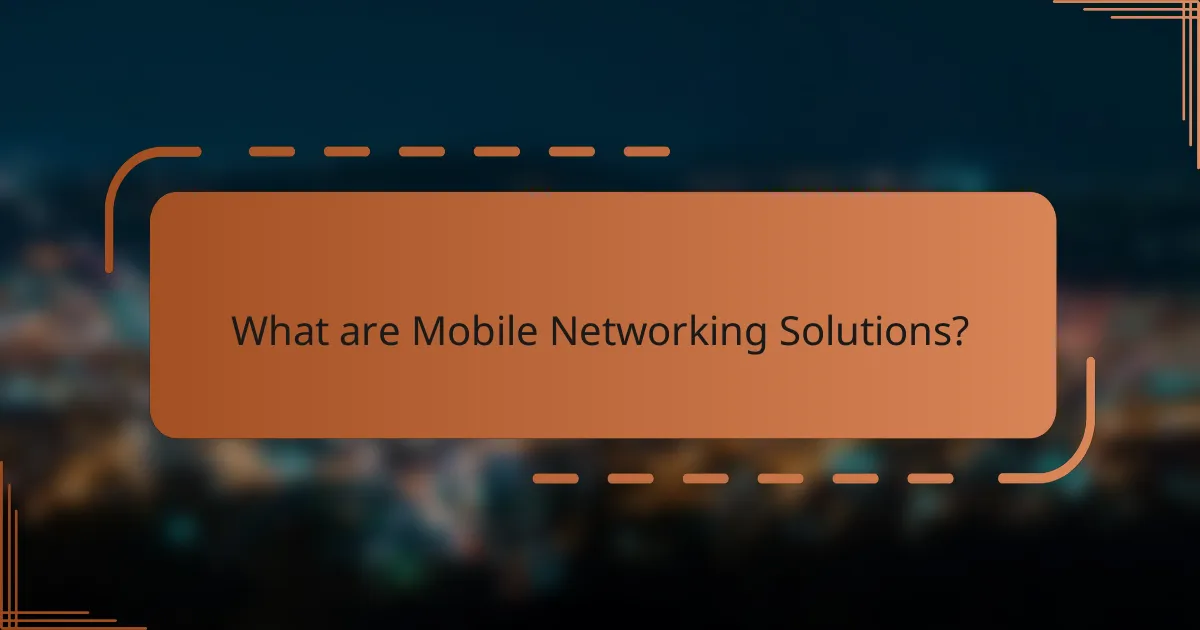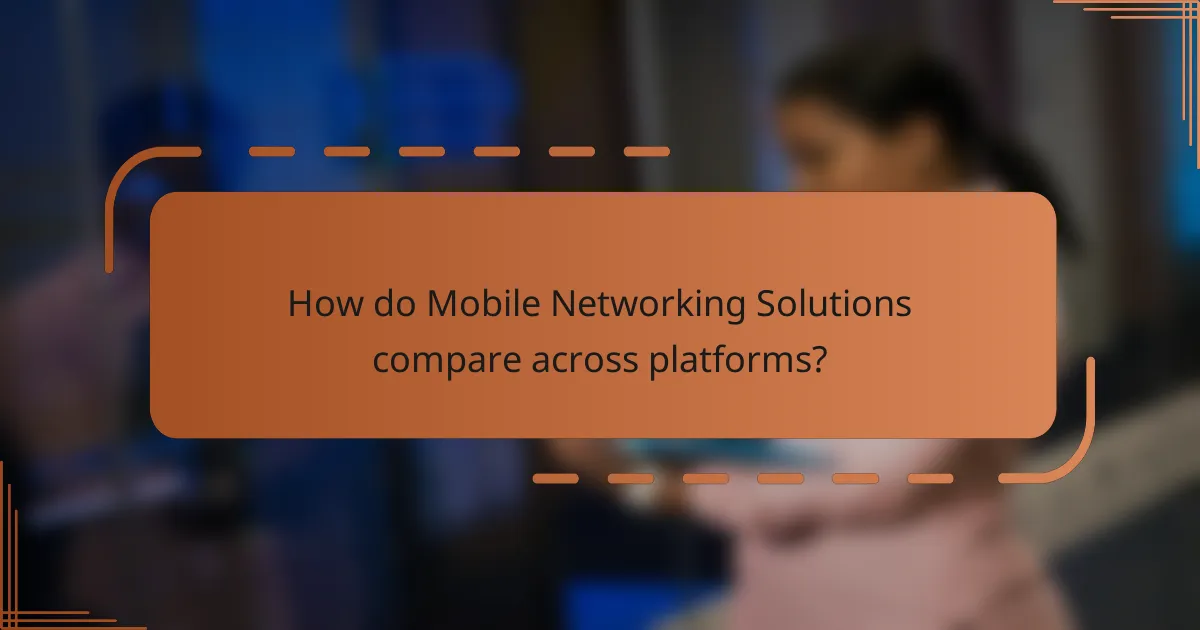Mobile networking solutions encompass the technologies and services that enable wireless communication for mobile devices, facilitating connectivity through cellular networks, Wi-Fi, and satellite systems. These solutions are crucial for applications such as mobile broadband, IoT devices, and mobile enterprise solutions, contributing significantly to global GDP. Key features of mobile networking solutions include coverage, speed, reliability, scalability, security, compatibility, cost-effectiveness, and support services. The article will compare various platforms, highlighting differences in performance metrics and features, particularly focusing on the advancements from 3G to 5G networks and their implications for users and businesses.

What are Mobile Networking Solutions?
Mobile networking solutions refer to technologies and services that enable wireless communication for mobile devices. These solutions facilitate connectivity through various platforms such as cellular networks, Wi-Fi, and satellite systems. They support data transfer, voice communication, and internet access for users on the move. Mobile networking solutions are essential for applications like mobile broadband, IoT devices, and mobile enterprise solutions. According to the GSMA, mobile connectivity accounts for over 5% of global GDP, highlighting its significance in modern communication.
How do Mobile Networking Solutions function?
Mobile networking solutions function by establishing wireless communication between devices through radio frequency signals. These solutions utilize various technologies, such as 4G LTE and 5G, to enable high-speed data transfer. Mobile networking solutions rely on a network infrastructure that includes base stations, antennas, and core networks. Base stations connect mobile devices to the network and manage communication traffic.
Data is transmitted in packets, allowing for efficient use of bandwidth. The core network processes these packets and routes them to their intended destinations. Mobile networking solutions also implement protocols for security and data integrity. For instance, encryption methods protect user data during transmission.
According to the GSMA, 5G networks can achieve speeds up to 10 Gbps, significantly enhancing mobile networking capabilities. This technology supports a greater number of connected devices, improving overall network performance.
What are the key components of Mobile Networking Solutions?
The key components of Mobile Networking Solutions include radio access networks, core networks, and transport networks. Radio access networks facilitate wireless communication between mobile devices and base stations. Core networks manage data routing and service delivery across the mobile network. Transport networks provide the necessary infrastructure for data transmission between different network elements. Each component plays a critical role in ensuring seamless connectivity and performance in mobile networking.
How do these components interact within Mobile Networking Solutions?
Mobile networking solutions consist of various components that interact to facilitate communication. These components include base stations, mobile devices, and core network elements. Base stations transmit and receive signals to and from mobile devices. Mobile devices, such as smartphones, connect to these base stations for data and voice services. Core network elements manage data routing and user authentication.
These interactions enable seamless connectivity and data transfer. For instance, when a user makes a call, the mobile device sends a signal to the nearest base station. The base station relays this signal to the core network, which connects the call to the intended recipient. This process involves various protocols ensuring data integrity and security.
The efficient interaction of these components is crucial for network performance. High-quality mobile networking solutions optimize these interactions to reduce latency and improve throughput. For example, advancements in 5G technology enhance the speed and reliability of these interactions, supporting more simultaneous connections.
What are the primary types of Mobile Networking Solutions?
The primary types of mobile networking solutions include 4G LTE, 5G, and Wi-Fi. 4G LTE is widely used for mobile broadband services. It provides high-speed internet access with low latency. 5G is the latest generation, offering significantly faster speeds and greater capacity. It supports advanced applications like IoT and smart cities. Wi-Fi, while not a cellular technology, is essential for mobile connectivity in various environments. It allows devices to connect to the internet wirelessly within a limited range. Each type addresses specific user needs and use cases in mobile networking.
What distinguishes different types of Mobile Networking Solutions?
Different types of mobile networking solutions are distinguished by their architectures, technologies, and use cases. For instance, 4G LTE provides high-speed data with low latency, primarily for mobile broadband. In contrast, 5G networks offer enhanced speed, capacity, and connectivity for IoT applications.
Another distinction lies in the deployment types. Public networks are widely accessible, while private networks serve specific organizations, enhancing security and control. Additionally, solutions can vary based on frequency bands used, impacting coverage and performance.
Network slicing in 5G enables tailored services for different applications, showcasing flexibility not found in earlier technologies. The choice of mobile networking solution often depends on specific requirements such as bandwidth, latency, and user density, which influences overall performance metrics.
How do various types address specific networking needs?
Various types of mobile networking solutions address specific networking needs through distinct features and capabilities. For instance, 4G networks provide high-speed data transmission suitable for streaming and video conferencing. In contrast, 5G networks offer ultra-low latency and increased capacity, enabling real-time applications like remote surgery and autonomous vehicles. Wi-Fi networks cater to localized needs, providing reliable connectivity in homes and businesses. Mesh networks enhance coverage and reliability by allowing multiple nodes to communicate seamlessly. Each type is designed to meet specific demands, such as speed, latency, and coverage area, ensuring optimal performance for various applications.

What features should be considered in Mobile Networking Solutions?
Key features to consider in mobile networking solutions include coverage, speed, and reliability. Coverage determines the geographical area where the network is accessible. Speed is crucial for data transfer rates and overall user experience. Reliability ensures consistent performance and minimal downtime. Scalability is also important, allowing the network to expand as demand increases. Security features protect user data from unauthorized access. Additionally, compatibility with various devices enhances usability. Cost-effectiveness is essential for budget considerations. Finally, support and maintenance services can influence long-term satisfaction and performance.
How do features impact the performance of Mobile Networking Solutions?
Features significantly impact the performance of Mobile Networking Solutions. They determine data transfer rates, connectivity stability, and user experience. For example, advanced encryption features enhance security but may slow down data transmission. Quality of Service (QoS) features prioritize traffic, improving performance during high usage. Network slicing allows tailored connectivity, optimizing resources for different applications. The presence of 5G capabilities boosts speed and reduces latency compared to older technologies. Additionally, features like Load Balancing distribute network traffic efficiently, preventing bottlenecks. Each feature contributes uniquely to overall system performance, making their selection crucial for optimal operation.
What are the essential features to evaluate in Mobile Networking Solutions?
Essential features to evaluate in Mobile Networking Solutions include network coverage, data speed, and reliability. Network coverage determines the geographical area where the service is available. Data speed affects the performance of applications and user experience. Reliability indicates the consistency of the service without interruptions.
Additional features include security protocols, which protect data integrity and user privacy. Scalability allows the solution to grow with increasing user demands. Cost-effectiveness evaluates the overall value relative to service quality. Customer support quality is crucial for resolving issues quickly.
These features collectively influence the effectiveness and suitability of mobile networking solutions for specific needs.
How do advanced features enhance user experience?
Advanced features enhance user experience by providing increased functionality and personalization. These features often include intuitive interfaces, faster processing speeds, and improved connectivity options. For instance, advanced data compression techniques can reduce load times, leading to a smoother experience. Enhanced security features protect user data, fostering trust and encouraging engagement. Additionally, customization options allow users to tailor their experience to their preferences. According to a study by Nielsen Norman Group, usability improvements can increase user satisfaction by up to 80%. Overall, these enhancements lead to higher retention rates and more positive interactions with mobile networking solutions.
What performance metrics are crucial for Mobile Networking Solutions?
Crucial performance metrics for Mobile Networking Solutions include latency, throughput, and reliability. Latency measures the time taken for data to travel from source to destination. A lower latency indicates a more responsive network. Throughput refers to the amount of data transmitted over the network in a given time. Higher throughput signifies better performance and user experience. Reliability assesses the network’s ability to maintain consistent performance without interruptions. Metrics like packet loss and availability are essential for evaluating reliability. Additionally, user experience metrics such as connection setup time and handover success rate are important. These metrics collectively determine the effectiveness and efficiency of mobile networking solutions.
How do latency and bandwidth affect Mobile Networking Solutions?
Latency and bandwidth significantly impact mobile networking solutions. Latency refers to the time delay in data transmission. Higher latency can result in slower response times, affecting user experience. Bandwidth measures the maximum data transfer rate. Limited bandwidth can lead to congestion and slower speeds during peak usage. Together, high latency and low bandwidth can hinder the performance of applications, particularly those requiring real-time communication, such as video calls and online gaming. For instance, 4G networks typically have latency around 30-50 milliseconds, while 5G networks can reduce this to 1 millisecond, enhancing performance. Thus, optimizing both latency and bandwidth is crucial for effective mobile networking solutions.
What role does reliability play in performance metrics?
Reliability is crucial in performance metrics as it ensures consistent and accurate measurement of network performance. Reliable metrics provide a true reflection of the system’s capabilities and limitations. In mobile networking, reliability affects user experience, influencing factors like connection stability and data throughput. High reliability in metrics leads to better decision-making for network optimization. For instance, a study by the International Telecommunication Union (ITU) highlights that reliable performance metrics significantly improve user satisfaction in mobile networks. Hence, reliability directly correlates with the effectiveness of performance evaluations in mobile networking solutions.

How do Mobile Networking Solutions compare across platforms?
Mobile networking solutions vary significantly across platforms. Key differences include performance metrics, compatibility, and features. For instance, 4G LTE offers faster speeds than 3G, while 5G provides even lower latency and higher bandwidth. Compatibility varies; some solutions support multiple devices, while others are platform-specific. Features like security protocols and network management tools also differ. According to a report by the GSMA, 5G networks are expected to cover 65% of the global population by 2025, highlighting the rapid evolution of mobile networking solutions. These factors collectively influence the choice of networking solutions for businesses and consumers.
What criteria should be used for comparing Mobile Networking Solutions?
The criteria for comparing mobile networking solutions include coverage, speed, latency, and scalability. Coverage refers to the geographical area where the network provides service. Speed is measured in data transfer rates, typically in Mbps or Gbps. Latency indicates the time taken for data to travel from source to destination, measured in milliseconds. Scalability assesses the network’s ability to handle increased loads or expand to accommodate more users. Additional criteria may include security features, cost of deployment, and support for various devices and technologies. These factors are essential for determining the overall effectiveness and suitability of a mobile networking solution for specific needs.
How do different platforms stack up in terms of features?
Different platforms in mobile networking solutions offer varying features tailored to specific needs. For instance, Platform A excels in real-time data analytics, providing insights within seconds. Platform B focuses on user-friendly interfaces, enhancing accessibility for non-technical users. Platform C prioritizes security features, incorporating advanced encryption protocols.
Additionally, Platform D supports cross-platform integration, allowing seamless communication between diverse systems. Platform E offers scalability options, accommodating growth without performance loss. Each platform’s unique feature set is designed to address different user requirements and industry demands.
In a comparative analysis, it is crucial to evaluate these features based on performance metrics, user needs, and operational environments. This ensures that users select the most suitable platform for their specific networking challenges.
What performance metrics can be used for cross-platform comparison?
Performance metrics for cross-platform comparison include latency, throughput, and packet loss. Latency measures the time taken for data to travel from source to destination. Throughput indicates the amount of data transmitted successfully over a network in a given time. Packet loss refers to the percentage of packets that do not reach their destination. These metrics are essential for evaluating the efficiency of mobile networking solutions across different platforms. Studies show that lower latency and higher throughput correlate with better user experiences. For example, a report by Cisco highlights that a 10% increase in throughput can enhance application performance significantly.
What are the advantages of specific Mobile Networking Solutions platforms?
Specific Mobile Networking Solutions platforms offer enhanced connectivity, scalability, and security. They enable seamless communication across devices and networks. These platforms often support various protocols, ensuring compatibility with existing infrastructure. Additionally, they provide robust data management capabilities. This allows for efficient handling of large volumes of data traffic. Many platforms also include advanced analytics tools. These tools help in monitoring network performance and optimizing resource allocation. Furthermore, some solutions feature cloud integration, facilitating remote access and management. These advantages contribute to improved operational efficiency and user experience.
How do unique attributes of platforms influence user choice?
Unique attributes of platforms significantly influence user choice by providing distinct features and functionalities. Users often prioritize attributes such as speed, reliability, and user interface. For example, a platform with superior data transfer speeds is likely to attract users who require quick access to information. Additionally, unique security features can sway users concerned about data privacy. Platforms that offer seamless integration with other services may appeal to users looking for convenience.
According to a study by Statista, 70% of users consider platform features before making a choice. This indicates that unique attributes play a crucial role in decision-making. Ultimately, user choice is shaped by how well these unique attributes align with individual needs and preferences.
What rare features set certain platforms apart from others?
Certain platforms in mobile networking solutions are distinguished by unique features. For example, some platforms offer advanced AI-driven analytics for real-time data processing. Others may provide unparalleled security protocols, such as quantum encryption. Additionally, unique integration capabilities with IoT devices can set a platform apart. Some platforms also feature customizable user interfaces tailored to specific industries. Furthermore, exclusive partnerships with telecom providers can enhance service quality and coverage. These rare attributes contribute to a platform’s competitiveness in the market.
What best practices should be followed when choosing Mobile Networking Solutions?
When choosing mobile networking solutions, evaluate your specific needs first. Identify the required bandwidth and coverage area. Consider the number of devices that will connect to the network. Assess the compatibility with existing infrastructure. Review the security features offered by the solution. Check for scalability options to accommodate future growth. Analyze the total cost of ownership, including installation and maintenance. Research the provider’s reputation and customer support quality. These practices ensure you select a solution that meets both current and future demands effectively.
How can users ensure they select the right Mobile Networking Solution for their needs?
Users can ensure they select the right Mobile Networking Solution by assessing their specific requirements first. Identifying needs involves understanding data usage patterns and connectivity preferences. Users should evaluate the coverage area and network reliability. Analyzing performance metrics, such as speed and latency, is crucial. Comparing features like security options and scalability helps in decision-making. Additionally, reviewing customer feedback and expert recommendations provides insights into user satisfaction. Research indicates that aligning solutions with user needs enhances overall effectiveness and satisfaction.
What common challenges should users be aware of when implementing Mobile Networking Solutions?
Common challenges when implementing Mobile Networking Solutions include network coverage issues, device compatibility, and security concerns. Users often face limited coverage in rural areas, which affects connectivity. Device compatibility can vary, leading to performance discrepancies across different hardware. Security is a major concern, as mobile networks are vulnerable to attacks and data breaches. Additionally, managing bandwidth and latency can be challenging, impacting user experience. Users must also consider the complexity of integration with existing systems. Finally, ongoing maintenance and updates require resources and expertise.
Mobile networking solutions encompass technologies and services that facilitate wireless communication for mobile devices, including cellular networks, Wi-Fi, and satellite systems. This article provides a comprehensive comparison of different mobile networking platforms, their features, and performance metrics. Key components of these solutions, such as radio access networks and core networks, are examined alongside their functionality in enabling seamless connectivity. Additionally, the article discusses essential features to consider, common challenges, and how various types of mobile networking solutions address specific user needs. Performance metrics like latency and throughput are also analyzed to help users make informed decisions when selecting mobile networking solutions.


